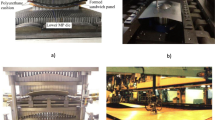Abstract
In order to realize the rapid forming of three-dimensional surface, a new process based on the continuous cold rolling with curved rigid roll is proposed. In this process, the transversal bending deformation of metal plate is caused by the rolls shape; at the same time, it is unevenly thinned by the symmetry uneven roll gap composed by the upper and lower roll; the longitude deformation is caused. With the rolls rotating, the metal plate is continuously formed; the three-dimensional surface is produced. The formation mechanism of three-dimensional surface is stated; the theory and method of three-dimensional surface rolling forming controlling are presented; the longitude bending deformation caused by unevenly thickness thinning is analyzed, and the formula of bending deformation in the longitude direction is deducted, and the calculation method of roll gap and roll contour curve is established. A small test device is developed to form the convex and saddle surfaces, and the forming results are measured and analyzed by numerical simulation. The results indicate that curved rigid roll rolling process is feasible and effective for forming three-dimensional surface.






















Similar content being viewed by others
Data availability
The data and material described were an original research that has not been published previously, and my manuscript has no associated data or the data will not be deposited.
Code availability
Not applicable.
References
Li G (2010) Some new topics on process design and mould manufacture for sheet metal forming[J]. Journal of Mechanical Engineering 46(10):31
Reutzel EW, Zhang L, Michaleris P (2006) A differential geometry approach to analysis of thermal forming[J]. Int J Mech Sci 48(10):1046–1062
Hemmati SJ, Shin JG (2007) Estimation of flame parameters for flame bending process[J]. Int J Mach Tool Manu 47(5):799–804
Wang T, Platts MJ, Levers A (2006) A process model for shot peen forming[J]. J Mater Process Technol 172(2):159–162
Wang T, Platts MJ (2002) A computer-aided blank design method for the peen forming process[J]. Journal of Materials Processing Tech 122(2):374–380
Shi Y, Yao Z, Shen H, Hu J (2006) Research on the mechanisms of laser forming for the metal plate[J]. Int J Mach Tool Manu 46(12-13):1689–1697
Simchi A, Petzoldt F, Pohl H (2001) Direct metal laser sintering: Material considerations and mechanisms of particle bonding[J]. International Journal of Powder Metallurgy 37(2):49–61
Mao F, Mo JH, Huang SH (2006) Study on instability of the point bolster sheet metal dieless forming[J]. J Mater Process Technol 176(1-3):13–18
Ambrogio G, Napoli LD, Filice L, Gagliardi F, Muzzupappa M (2005) Application of Incremental Forming process for high customised medical product manufacturing[J]. Journal of Materials Processing Technology, 2005 162(10):156–162
Li M, Liu Y, Su S, Li J (1999) Multi-point forming: a flexible manufacturing method for a 3-d surface sheet[J]. J Mater Process Technol 87(1-3):277–280
Gong XP, Li MZ, Hu ZQ, Cai ZY (2010) Research on continuous multi-point forming technology for three-dimensional sheet metal[J]. International Journal of Materials & Product Technology, 2010 38(2-3):210–222
Li M Z (2007). Method of multipoint continuous forming for the freeform surface parts. Chinese Journal of Mechanical Engineering[J], 43(12).
Cai ZY, Li MZ, Lan YW (2012) Three-dimensional sheet metal continuous forming process based on flexible roll bending: principle and experiments[J]. J Mater Process Technol 212(1):120–127
Li RJ, Li MZ, Qiu NJ (2013) Development of flexible rolling device for 3D plate[J]. Appl Mech Mater 271-272:852–857
Hu ZQ, Li MZ, Cai ZY, Gong XP (2009) Continuous flexible forming of three-dimensional surface parts using bendable rollers[J]. Materials Science & Engineering A 499(1-2):234–237
Wang P (2011) Research and application of the flatness measurement calculation model on cold rolling mill[J]. Journal of Mechanical Engineering 47(4):58
Dong Y (2010) Theoretical and experimental research on the elongation law of the rail in rail rolling by a universal mill[J]. Journal of Mechanical Engineering 46(6):87–92
Funding
This study is supported by the Program for Innovative Research Team of Jilin Engineering Normal University.
Author information
Authors and Affiliations
Contributions
Hengyi Yuan and Yi Li contributed to the conception of the study; Hengyi Yuan performed the experiment and significantly the analysis and manuscript preparation; Hengyi Yuan and Yi Li performed the data analyses and wrote the manuscript; Hengyi Yuan and Yi Li performed the analysis with constructive discussions.
Corresponding author
Ethics declarations
Conflict of interest
The authors declare that they have no conflict of interest.
Ethics approval and consent to participate
The work described was original research that has not been published previously, and also not under consideration for publication elsewhere, in whole or in part. All the authors have approved to participate in the manuscript.
Consent for publication
The manuscript is approved by all authors for publication.
Additional information
Publisher’s note
Springer Nature remains neutral with regard to jurisdictional claims in published maps and institutional affiliations.
Rights and permissions
About this article
Cite this article
Yuan, Hy., Li, Y. Device design and forming process analysis of curved rigid roll rolling process for three-dimensional surface. Int J Adv Manuf Technol 113, 2481–2493 (2021). https://doi.org/10.1007/s00170-021-06679-2
Received:
Accepted:
Published:
Issue Date:
DOI: https://doi.org/10.1007/s00170-021-06679-2



